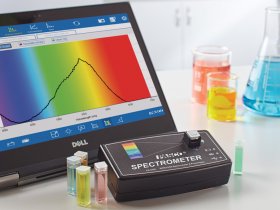Replacement Polystyrene Cuvettes and Caps for the PASCO Wireless Spectrometer.
- 1x Cuvettes (100)
- 1x Cuvette Caps (100)
Product Summary
This is a set of 100 identical 3.5 mL polystyrene cuvettes and caps.
Replacement Cuvettes and Caps for the PASCO Wireless Spectrometer. Includes 100 cuvettes and 100 caps. These cuvettes are made from polystyrene. Great for use with the PS-2600 for work in the visible spectra. Use only solutions to which polystyrene shows good chemical resistance within these cuvettes - NOT compatible with strong organic solvents like acetone.
What's Included
- 1x Cuvettes (100)
- 1x Cuvette Caps (100)
Product Specifications
| Cuvettes | Standard 3.5 mL polystyrene cuvettes, 10 mm path length, 45 mm height. |
Product Guides & Articles
Spectrometers
A spectrometer is a device that allows scientists to dissect light into its constituent colors, akin to separating the vibrant hues of a rainbow. By precisely dispersing the light, spectrometers provide a unique window into the physical and chemical properties of objects.
Experiment Library
Perform the following experiments and more with the Cuvettes and Caps.
Visit PASCO's Experiment Library to view more activities.
The Water Cycle
Students use a turbidity sensor, a conductivity sensor, and a condenser to explore how energy drives the movement and purification of water through Earth’s systems.
Project: Design a Purification Process
Students must engineer a system to purify water that contains macroscopic and microscopic contaminants and evaluate the effectiveness of their design using a condenser, turbidity sensor, conductivity sensor, and qualitative observations.
Colored Solutions
Students use a colorimeter to develop an understanding of how different wavelengths of light interact with particles of a colored solution to produce the solution color seen.
Solution Concentration
Students use a colorimeter to construct a calibration curve of known solution concentrations and determine the unknown concentration of a solution (Beer’s law).
Chlorophyll Extraction
Students use a colorimeter to investigate which wavelengths of light are best absorbed by green plants.



